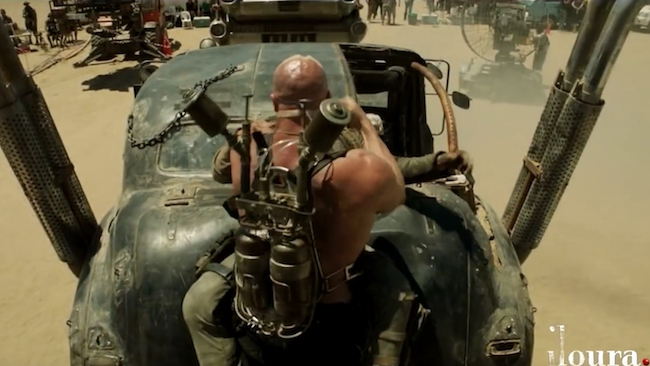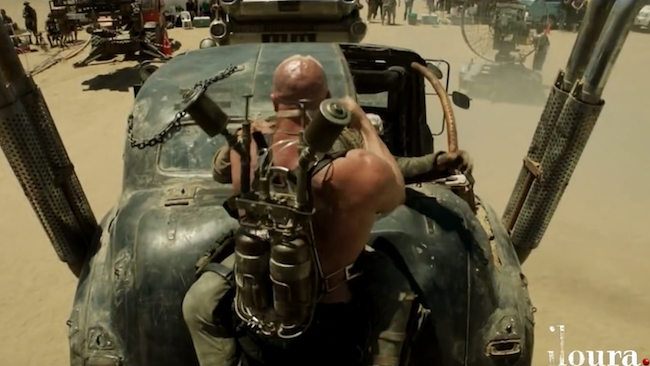
 That truck ain't moving nowhere...
That truck ain't moving nowhere...
Awards season is almost upon us and as far as visual effects work goes, the American Academy and British BAFTA voters are broadly in agreement. Here are some suitably stunning breakdowns...
A new year inevitably means a fresh round of controversy over film and TV awards ceremonies. In 2014 it was the turn of BAFTA, with a whistleblower claiming that many judges vote for films they haven’t seen. This year, it’s the turn of the Academy Awards, with controversy and boycotts inevitably following the lack of representation for Latino, black and other non-white industry members in the list of nominees.
The Academy is, at least, on safer ground with its nominations for the Best Visual Effects and Best Animated Feature categories. The latter category is perhaps surprising for the absence of The Peanuts Movie, arguably the finest CG re-interpretation of a beloved pen-and-paper franchise to date. Full marks, however, for the inclusion of Studio Ghibli’s latest When Marnie Was There, along with Boy And The World, an artistically ambitious work from little-known Brazilian filmmaker Alê Abreu. Charlie Kaufman’s stop-motion tale Anomalisa, Aardman’s Shaun The Sheep Movie and - somewhat predictably - Pixar’s Inside Out complete the list. BAFTA has just three titles in the running: Inside Out, Minions and The Shaun The Sheep Movie.
Over in the Visual Effects category, Ex Machina, Mad Max: Fury Road, Star Wars: The Force Awakens, The Martian and The Revenant are all jostling for prizes. This broadly chimes with those chosen by the BAFTA voters, albeit with Ant-Man included rather than The Revenant.
Ex Machina
Movies that dare to utilise visual effects for the creation of a lead character are few and far between. Those that do so on a budget of just $15 million are non-existent, at least until director Alex Garland and vfx studio Double Negative worked together to transform Alicia Vikander’s on-set performance into a masterclass in cyber-sexual fetishism. Perfect tracking and paint work help transform the computer-animated hardware into integral character and story elements.
The Revenant
The OSCAR nod for Alejandro González Iñárritu’s ode to the cruel beauty of nature (both the regular and human varieties) will come as a surprise to many, not least because the director has been reluctant to discuss the use of any cinematic sleight of hand during the film’s gruelling, protracted production. In fact ILM, MPC and Cinesite all helped out, and only in the last few weeks has Iñárritu come clean about the use of a CG creature in scenes where Leo DiCaprio’s character is practically torn apart by a bear. Sadly no amusing behind the scenes footage of either ILM’s digital creation or the man-in-suit who originally acted out the sequence on set have yet been released.
Star Wars: The Force Awakens
No surprise that Disney handed over the sizeable visual effects workload for the first release from the freshly purchased Lucasfilm to that division’s own ILM team. Director JJ Abrams made a point of stressing the use of practical sets and puppeteering on-set, yet some 2,100 of the movie’s 2,500 shots still include some degree of vfx enhancement. These ranged from tiny fixes for R2-D2 and BB-8 animatronics to fully digital dogfights and all-CG characters like Maz Kanata and Supreme Leader Snoke. Wired Magazine’s behind-the-scenes featurette touches on some of ILM’s key contributions.
The Martian
No stranger to fashioning alien landscapes for director Ridley Scott (having performed similar duties on Prometheus), MPC turned its hand to something more scientifically grounded for the veteran director’s latest. Working with input from NASA itself, the studio’s artist enhanced footage in studio and on location in Jordan’s Valley Of The Moon to build a convincing depiction of Mars and its disruptive weather systems. Even the astronauts’ helmets were augmented, with visors and reflections added in post. The movie it unlikely to steal awards from its showier rivals, but is an artistically impressive achievement nonetheless.
Ant-Man
BAFTA nominee Ant-Man may be Marvel’s most intimate superhero tale to date, but it’s by no means lacking in spectacle. Countless sequences with characters shrinking, growing, interacting with various subspecies of ant, plus setpieces involving such oddities as scaled down fight aboard a Thomas The Tank Engine train set gave ILM, Method, LUMA, Cinesite, and Double Negative plenty to deal with. Also notable is an impressive prologue featuring a de-aged Michael Douglas as a 1960s’ incarnation of Ant-suit creator Hank Pym. For this sequence Marvel called on Lola, the studio that helped turn Chris Evans into a nine stone weakling for Captain America: The First Avenger.
I
Mad Max: Fury Road
When George Miller’s resurrection of his own groundbreaking post-apocalyptic franchise barged its way into cinemas in mid-2015, great pains were taken to stress just how much this old-school blockbuster contrasted with effects-heavy peers. The director noted that 90 percent of the film involved practical effects, and everybody duly marvelled at the astonishing vehicular destruction. Then came B-roll footage revealing how just how many action sequences were shot with static vehicles and greenscreen. Now, behind-the-scenes footage from Iloura and Method Studios further fleshes out the details of what is clearly a near-flawless blend of cinematography and visual effects work.
Tags: Post & VFX


Comments